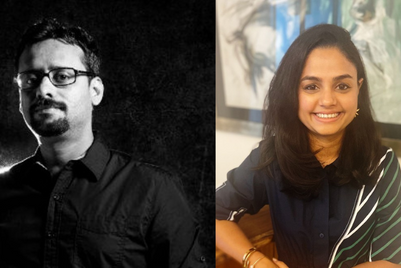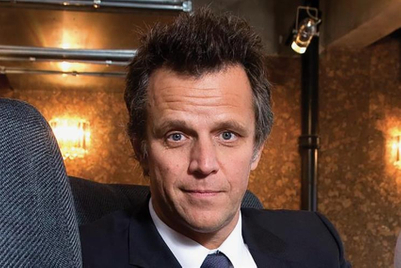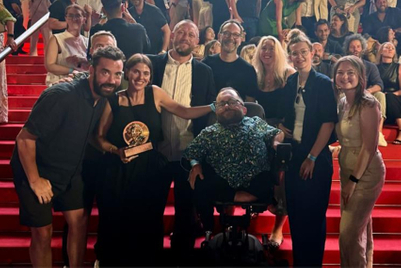
Asked about his 26 year-stint at BBH, the agency’s worldwide CEO Gwyn Jones quips, “I know it’s a rare thing. But then, if you hang around long enough and everyone else leaves, then they have to promote you.”
He’s also quick to point out that he’s just had lunch with a young group from the BBH India team, all of whom have joined the agency in the last year. “The most embarrassing part is that some of them weren’t even born when I started working here,” he adds. The new talent infusion is part of the young BBH India’s journey.
How are BBH offices across the world stacking up, beyond the flagship in London?
London is still the mother ship. It continues to be our biggest and strongest office. Despite an economically challenged Europe, London continues to be very strong for us. Within the UK context, it’s one of the biggest agencies as well - it’s got real scale and stature in that market place.
Our second largest business, by virtue of fantastic growth over recent years, has been Brazil. And then comes the US, followed by Singapore, China and India (which is our youngest business) in that order. Collectively, Asia would be 18 to 20 per cent of our business.
What’s happened recently, is that the kind of growth people were getting used to in Latin America and parts of what clients call ‘emerging markets’, has flattened. There are currency and other economic challenges as well. But clearly, we are very small; so we think there is enormous opportunity for us in all these markets.
What are the changes that have been evidenced in the last decade or so of global expansion?
One of the particular changes that we have observed more recently has to do with our model, of helping global brands manage on a regional basis. One of the ways we have grown our business over the last 15 to 20 years is by doing that.
Simon Clift (former global CMO) of Unilever once said global brand owners often get caught between being mindlessly global and hopelessly local. And the region became a good point of leverage for managing global brands. Over the last 10 years, as digital, activation and experiential has grown, they have pulled spend more local. And almost as a compensating force (because marketing budgets are often seen as a zero sum game), you get more concentration of brand-defining work at the global rather than the regional level. So the role of the regional office becomes more about being multi-local; (that is) on the balance of business, the share of local becomes more important.
Traction for an agency comes from work that has rich cultural impact, which give it great fame in a market. Often, that stands out more when you do it for local business, because it makes it easier to go to those culturally relevant places.
Talking about India specifically... we’re still extremely ambitious. Clearly, there have been other changes in our make up here. We’ve had a lot of change in our leadership. We’re extremely excited about the team we’ve got here now. Over the next few weeks, you’ll see a lot of work coming out into the market as a testament to the last few months of effort, which will put the focus on what this team is capable of.
What’s the split of work between global and local clients in India?
Our biggest client here is Unilever. But most of the wins recently have been for local assignments and the bulk of the client list is local. Unilever and Diageo are shared internationally, but even within Diageo, one of our biggest assignments here is for VAT 69. Clients like Marico and Skoda here are also not globally aligned relationships.
You mentioned that Brazil is your second largest market. How is the global versus local split there?
Brazil is a much more local market. That’s also a function of the slightly different nature of the business in Brazil (media consolidated with the creative business). And also because when we decided we wanted to open business in Brazil, the person we wanted to open business with already had his own business; so we already had some traction there (Neogama BBH).
How do you see the India business growing – more from local or global clients?
I think both and both are part of our focus. Global, not least because they give you a reason to collectively work together as a network. They are a strong bonding force. We are fortunate to work with some fantastic global brands. There are still lots of international brands that are working out how they might have a presence in India. And interestingly, the dialogue in India, China and Brazil is about national brands that are starting to think about how they can become global. In the past, that has been a one-way conversation about global brands coming to local markets.
Do you believe that BBH would be the agency of choice for an Indian brand going global? Is there reason to believe that they would rather grow with networks?
Obviously, the networks are very, very strong in India. So there is more of a chance that a local brand is already working with another network than perhaps would be the case in some other markets. But I believe in the power of our capabilities. It would obviously depend on the brand and the stage of the journey that they’re at.
BBH India - 2008 Vs 2013: How did you foresee the trajectory then and how do you view it now?
We probably thought in 2008 that it was going to be easier and we’d just ride the wave. I don’t think we ever imagined that we would have to endure some of the changes in the global economy, or some of the changes that we have had as a business here. But if I were to spin that around, there are aspects around a start up that you want to keep permanently in an agency.
Going back to 2008, we thought that by now, we could be a bigger business making more of an impact from India on the global stage. So you have to reset your expectations a little. I think also, the degree to which Indian brands have actually become exportable relationships - that hasn’t happened so much but I do think that will become more of a phenomenon in the future.
BBH has a strong identity and we know what it stands for. But, for want of a better phrase, a network can be (in a positive sense) more things to more people, in terms of spread and flexibility...
A lot of growth and a lot of our international business has come from brands who are going on that journey, but don’t want the ‘duplication’. The ‘Can be all things to all people’ can be a strength in some regards, but the focus and leanness that comes with our approach can be more relevant for some brands.
The flagship, BBH London, for many years, as we set off on the international journey, we probably allowed a situation whereby offices around the world were obsessed with how to be like BBH London. We’re very clear that the role of BBH in Mumbai is not to be a smaller version of BBH in London – it is to be the right agency for BBH in India, one that subscribes to our values, our belief in creativity, wants to produce work that works for clients, captures imagination through big ideas, and so on. That would only work if it produces work for the cultural context in which it sits. So it’s first and foremost about being the right agency for India. If you bring that collection of philosophies together, then you’ve got a good platform to enable brands to travel. You will then be coherent, but relevant.
Tell us about running BBH in the US... how different was it culturally?
It was both an enormous challenge and very easy. It was easy in the sense that although the context was completely different, I went to work every day, to work with people who had already bought into a set of values that I was comfortable with. It was like being amongst friends, immediately. And they had some fantastic people there.
And it was very difficult, because the brand was very well known within the advertising community, but it was unknown amongst the client community. The way the business operated over there was very different.
Like a lot of British businesses when they go to the States, we had gone to New York. And then you realised that in the eyes of a lot of people, New York is an island off the East coast of America. The rest of America has a very different mindset; very different cultures within. You’ve got to get your head around a lot of different communities. India is multiple of that in terms of depth of understanding of differences that is required.
Also, we had got on the map enough with consultants when I got there, to sort of getting started to being included in pitch lists for serious businesses, with account sizes in the range of 50 to 100 million dollars. I felt we were producing great work, we had very good people. But we didn’t have the scale to be a serious contender for those accounts. What I did was think of building a critical mass, by lowering our size for a year or so. We won some (smaller) business so we had the critical mass, to take on larger assignments. By the time I left in 2007, we were twice the size, we were Midsize Agency of the Year. We had a pretty good run. I feel like we had a good period of growth both creatively and commercially.
The issue in America is that just like the winds are big, the hits are big as well. One of the things that was very different culturally for us from the UK, was that, our approach is generally very organic – with incremental organic growth over many years. If you part company with some client for some reason, the shocks and winds in the US are much bigger. We had a difficult year last year in the US with some sizeable bumps like that. But we’ve had a very good year this year – Playstation was a big win at the start of the year and we are about to announce another significant win.
There must be a huge line waiting to join BBH London. How does BBH as a talent magnet work in other markets? How is it in India?
I think it’s very strong. Even in markets where we don’t have a business or our business is relatively strong, or presence is relatively recent, our brand is very well known within the industry. Sometimes less so within the broader marketing community, but within the industry, it continues to be fantastically strong. That is a tribute to the work and the focus on the work that the business has always had. A lot of businesses have peak, a purple patch for a few years. But there aren’t many businesses that have maintained their focus over their lifetime as an agency. We continue to want that to be the focus. There are a few agencies, like Wieden and BBH, which have managed to maintain that profile and focus over time.
I think that says something to talent. Talent attaches itself to a culture and an agency. That is deeper than any one individual, any CEO or any creative director. Our culture is a fixed part of our identity; we want creativity to be the driving heart of the business.
We’re very, very fortunate in that we’re often able to punch above our weight in the talent that we’re able to attract for the size of business that we are, particularly in the younger markets.
We’ve seen Arvind Krishnan go out to London for a stint and come back now. How do you view rotation of talent? Global exposure would be an incentive too, for talent...
Absolutely. I’m so delighted that we’re able to make that happen. We get tighter as a network when people move around and work in different places. In the early part of our international business, that had almost always been about people moving from London to different offices.
Now, we’ve had people going across offices, not just to London. We’ve had people moving from Singapore to New York (and so on). That’s when it really works, not least because sometimes those people want to move permanently; sometimes they want to go home. When people carry a bit of somewhere else back with them, I think it’s profoundly valuable.
So I’m extremely excited about Anand coming here. He also has the benefit of being part of this team. He had worked closely with Sanjay (Sharma) and Russell (Barrett) before. That team of four (with Subhash Kamath) is a new team, but they’ve all known each other and worked together for four years already. For the first time when changing the line up we’re actually putting together something that’s got proven credentials, great chemistry and a great fit – and that element of Arvind having had the experience of another office as well.
What’s your view on pitch consultants?
I’ve worked with pitch consultants in lots of situations where they have dramatically enhanced and improved the process of running a pitch. They bring a level of expertise, an understanding of agencies, and a management to the process which often creates conditions for the best ideas and best partnerships to prevail.
Equally, there are a lot of clients for whom it would be unnecessary. If they are so close to the agency, they don’t need that additional point of view and they’re good to handle pitches themselves.
People taking responsibility for clarity of process is a good thing. When pitching, you need clarity because you just want to understand the terms. With many clients, they feel the need to ‘get on with the day job’. However much a pitch is necessary, it can still be a distraction. The role of a consultant can be very important in that context.
What is your viewpoint on the disparity in salaries, especially at the entry level? It leads in no small way, to losing talent to other streams, especially in creative, like television...
And to tech companies - it’s happening all over. We’re going to have to find a way to compete. I’m not sure if the salary is the primary way we can compete, because it’s an incredibly aggressive, commercially driven, procurement-driven environment. Agencies are going to need to reinvent how they work in order to be able to deliver and command value. You have to be careful not to let those things become a vicious circle. You have to make some investment because if you just get driven down, then it gets worse and worse.
There are other things that are attractive. When I joined this industry, around the time, everybody wanted to become a merchant banker. I went to lots of those recruitment sessions and considered the fact that I might be starting on a salary that was a fourth or a fifth of what people in the financial services industry were going to start at.
There has always been a disparity in what we are able to pay talent at the entry level. But there are other values in our business. I love the environment, the fact that we are able to do different, creative things that are exciting to be a part of. You get the buzz of creating something that is culturally significant. We have to become better advocates of what is exciting and interesting about working in this business. But yes, we must also find different ways to generate and command value. I believe profoundly in the value that we can create for our clients.
The value has to go beyond advertising, some reason...
We have to understand our clients’ pressures. They are having to invest in many more channels in the marketing of their brands than advertising. The routes to market have expanded exponentially than the levels of growth they are able to achieve in their own business. Inevitably, even if it’s not a zero sum game, there is going to be some pressure and squeeze and compromise on the amount that is available for them to invest in the pure advertising service. Which is why, of course, all the holding companies have invested in diversifying.
One of the things that is exciting about our business here in India, is that it is a business born in a post TV-centric age. So from the outset, it’s been a business interested in the digital and social expressions that drive a core idea. Some of our younger businesses are easily adaptable to becoming more future-facing, than those that have legacy relationships.
The article appeared in the issue of Campaign India dated 18 October, 2013


.jpg&h=334&w=500&q=100&v=20250320&c=1)
.jpg&h=334&w=500&q=100&v=20250320&c=1)


.jpg&h=334&w=500&q=100&v=20250320&c=1)







.jpg&h=268&w=401&q=100&v=20250320&c=1)




.jpg&h=268&w=401&q=100&v=20250320&c=1)
